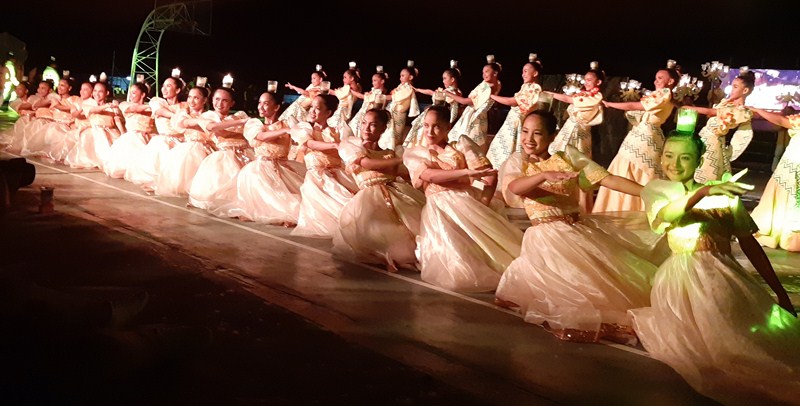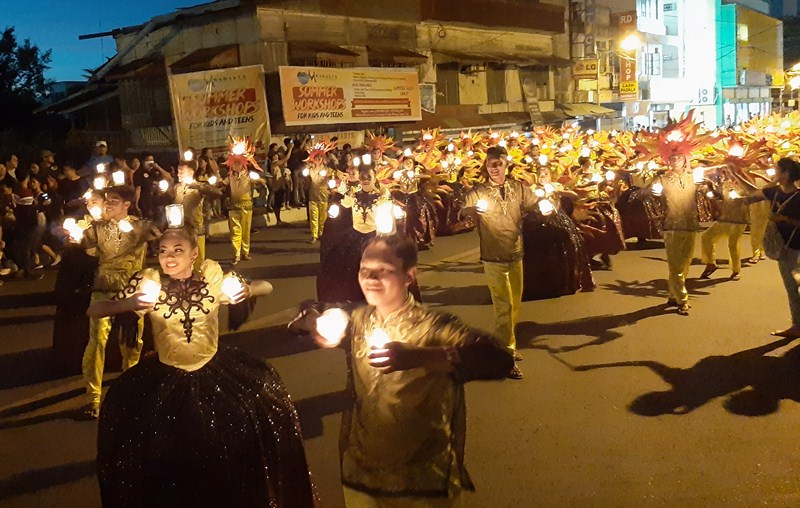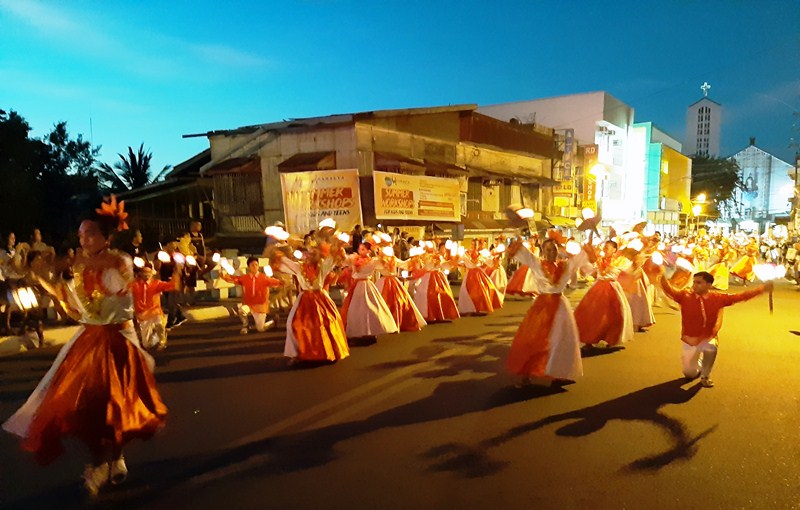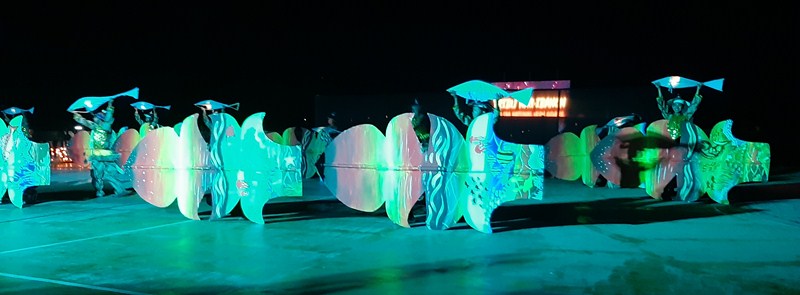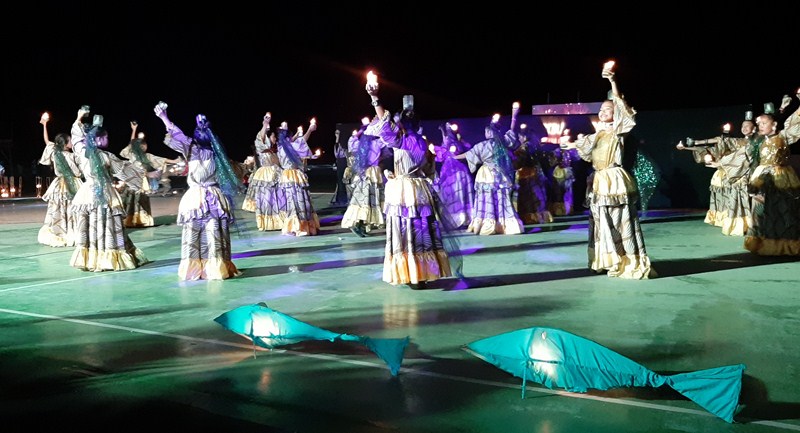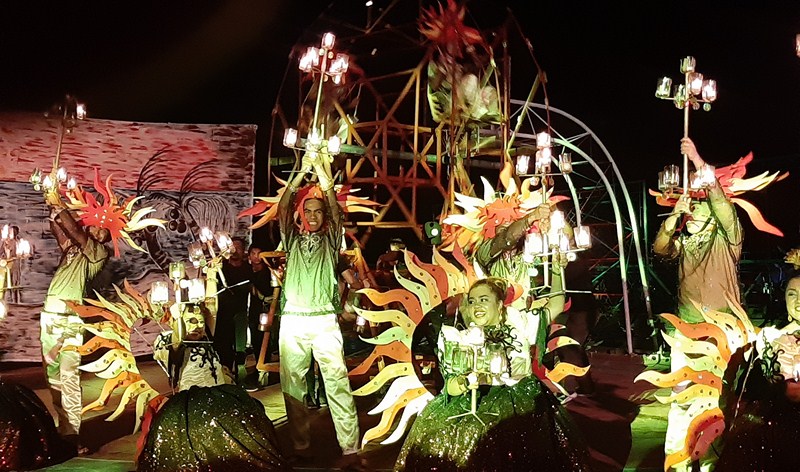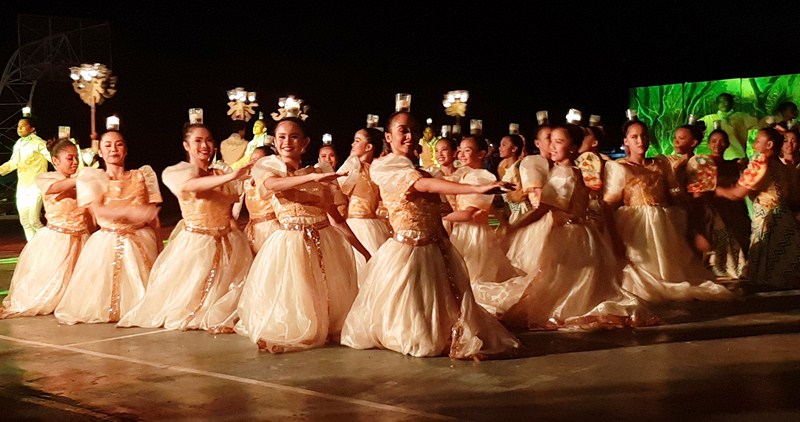After our dinner and interview of Gov. Alfonso Umali Jr. at Vencio’s Garden Seafood Café, we boarded our respective vans to cover the Pandang Gitab Parade, Oriental Mindoro’s “Festival of Lights.” The festival was usually held on the third Saturday of February but, as this month was usually rainy, it was held, for the first time, in the month of April.
The parade had already started at 6 PM (upon the sound of the pealing church bells which signaled the start of the oracion, the six ‘o clock prayer), at the Calapan City Plaza so we were dropped off along J.P. Rizal Street were we were to catch the parade as it approached the Oriental Mindoro National High School OMNHS) grounds where the in-place competition will take place.
The word pandang-gitab, which describes an old tradition of Mindoreños, was coined from the word pandango (descended from a Spanish-American dance performed by a man and woman) and the word dagitab (handmade lamp or portable light or “flicker of light”).
According to Kanami Namiki’s book “Ramon Obusan, Philippine Folkdance and Me,” the pandango is danced with regional and local variations such as lights (ilaw) in Mindoro and hats (sambalilo) in Bulacan.
The Filipino folk dance Pandango sa Ilaw (Dance of Lights), of Mindoro and Pangasinan, is a dance made up of two dances using lights. Dancers from Mindoro balance oil lamps on their head and on their palms while those from Pangasinan use lamps wrapped in dark-pink scarves. The Pandango sa Ilaw of Mindoro originated from Lubang Island.
The dance was inspired by the practice of wives from the coastal community of Mindoro who accompany their fishermen husbands going out to fish at the crack of early dawn. The burning wisps of their oil lamps light the way to the shore. Part of this practice is a ritual folk dance for a safe voyage and bountiful catch. The lights also provide a beacon for fishermen coming back from the sea. The annual Pandang Gitab, the street dancing festival inspired by this practice, is a nod to this tradition.
The Pandang Gitab, one of the much awaited celebrations in Oriental Mindoro, was first introduced as a street dance in November 2001 (51st founding anniversary of Oriental Mindoro) and has been held every year since then. At the national level, this lively street dance has already reached great popularity and promotional exposure.
In 2011, the Pandang Gitab Oriental Mindoro (“Oriental Mindoro” was added to imply exclusivity to the island where the festival is held) joined the Aliwan Fiesta competition, the country’s grandest fiesta celebration, which brings together, in a single setting, street dancing contingents from all over the country. According to Gov. Alfonso Umali, it brought home the 5th prize, beating other well-known contestants from around the country. Last year, it made it to the Top Ten, bringing home the 7th prize.
In 2012, during the recent celebration of the province’s 62nd founding anniversary, the “Pandang-Gitab” was declared and recognized as the official festival and cultural event of the island province, by virtue of Provincial Ordinance No. 25, and will now carry the banner of Oriental Mindoro. A far cry from the loud, usual drummed beats of older and more famous festivals (Ati-Atihan, Dinagyang, Sinulog, etc.) in the Philippines, street dancers here don colorful and glittery garbs, inspired from the traditional baro’t saya, and twirl and sway with the rural, lively tune (a composition of National Artist for Music (1988) Col. Antonino Buenaventura) of the pandango to relive the old and simple living of fisherfolk in the island.
Set at night, the event lit up the streets of Calapan City and the melodious Pandango sa Ilaw serenaded us as well as fiesta-goers. This unique aspect added to the annual festival’s allure. Though the influx of spectators are limited (usually it’s only from Calapan City and Baco area), this still nascent festival has a big potential to attract foreign and domestic tourists outside the province.
The dancers at this lively street dance parade where clad in colorful traditional Filipino costumes, with made up faces and coiffed hair. They queued and formed their lines, holding their gas lamps and candles in glasses. Then, they started to stomp their feet in triple time rhythm, grinding and swaying to the beat of Pandanggo sa Ilaw. The street was illuminated by the bright tongues of light of the three glittering oil lamps (tinghoy), or candles in glasses, balanced on the pandanggera (dancer’s) head and on the back of each hand.
On the other hand, the guys, with hands akimbo, dance to and fro, exchanging steps left and right and following the movement of the pandanggera. They all gyrated to the blaring beat of the song played repeatedly and continuously until all the six dance groups (from Calapan City and the municipalities of Socorro, Baco, and Pola), usually with 60 to 100 performers, had finished their turns. The sets and props were just as impressive, from stilts, bancas, a Ferris Wheel and even a lighthouse (parola). The Baco delegation, guided by folk choreographer Dr. Jay Mark Atienza, was declared as the Pandang Gitab Dance Parade Competition champion for the third consecutive year.
This annual Festival of Lights, which brings back the culture and old traditions of the Mindoreños, is truly unique from the other well-known Philippine festivals and I am optimistic it would catch the attention of fiesta revelers nationwide.
Provincial Tourism and Cultural Affairs Office: Provincial Capitol Complex, Calapan City 5200. Tel: (043) 286-7046 and (043) 441-0306. Website: www.ormindoro.gov.ph.

